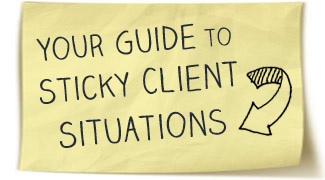
There is one unmistakable difference between the self-employed women who work long hours, have work on their brain all the time, and are barely scraping by, and those who take evenings and weekends off, stay on top of their work, and handily support their families.
Mindset.
It’s not that the latter group cares less about their businesses.
Just the opposite. They treat their businesses like a brick and mortar operation, with business processes, set hours, and concrete marketing.
They don’t expect “if you build it, they will come”-style magical inflows of clients.
Scarcity vs. Abundance
When you don’t see that the business sea is chock full of attractive client fish, you become overwhelmed by scarcity. The only client pool you see is the people who choose to advertise on job sites. If they don’t hire you, you feel like you can’t cut it.
If you do get a client, you feel you must do everything you can do to keep them no matter how low the pay or extravagant the work requests. Because who knows when a similar gig will come along and whether that person will want to hire you.
A scarcity mindset comes from a lack of self-confidence, not a lack of ability.
One freelancer I know had a very bad accident and a concussion that kept her from working for several months. She lost several clients, including her biggest, highest-paying client, because people needed things to get done and she was not able to provide during that period.
Did she think that it was time to give up and return to the 9-5 work force, where she would have had medical leave and disability pay while she was unable to work?
Not for a second.
She got online, emailed her heart out, and drummed so much new work in one month that she was making double what she had made before her accident.
How?
But, more importantly, why?
She knew that she provides a skill that businesses need and her current lack of work was more of a reflection on her lack of marketing than lack of opportunity in the market.
If you fill a need, there will always be more work. If you’re not finding it, you just need to look harder. More systematically. And don’t take it personally. It’s just business.
Say Goodbye and Don’t Look Back
If I tell you that dropping your lowest-paying client practically guarantees you will find better, higher-paying work, it’s hard to believe, right? Otherwise you would have done it already.
But I read stories about it all the time.
The logic is simple: if you don’t have that piece of business anymore, (a) you can use the time that you previously spent doing that work fishing for bigger fish, and (b) you have an opening that allows you to take advantage of opportunities you would otherwise be too busy for.
Even more, having a hole in your income stream puts a fire under your butt, like the freelancer I described earlier, that makes you do what it takes in terms of marketing until you can fill that hole with the money you need.
If you are especially nervous or in a tight financial position, consider dropping a small, low-paying client even if he or she is not your lowest payer. Look for someone who you took on when you first began your business, when your rates were lower, or someone you picked up during a period where you were desperate to fill in more work.
Caveat: Quite honestly, I cannot recommend anyone simply drop her lowest-paying client without knowing her financial situation. For some self-employed women, the lowest-paying client may currently be the only client or the biggest client, and in these cases, it’s best to juggle a little bit of extra work for a bit while transitioning to higher-paying clients to be safe.
Start Now—More Money is Waiting for You!
Before you drop your client, send them an email that you are raising your rates. Here’s a simple script to raise your rates:
Dear client,
Happy Thanksgiving/Holidays/Happy New Year/Good Afternoon (whatever opener you want to use)
I’m just writing to let you know that I have really enjoyed working with you this past year. I know that my work on _____________ (something you have done for the client) has helped you __________________ (some feedback you’ve gotten from the client or results), and I’m so glad I could help you meet your goals.
At the beginning of the new year, I’m going to be raising my rates, and I wanted to give you a heads up about the change. As I have grown over this year, particularly in terms of ______ (skills that you have gained this year, particularly experience with software or ___ the client uses), my rates will be adjusted accordingly.
Currently, I’m doing ______ (project/service) for you at $## per hour/project. Beginning January 1st, the rate for that will be $##.
If this is an issue with your budget, please let me know and we will discuss other options.
I look forward to continuing our fruitful collaboration!
Best,
You
Mention a serious enough raise that if they take you up on your new rate, you’d be happy to keep the client. If they up your fee, move on to the next low-payer until you find someone to replace.
Rinse and repeat:
- Offer to raise rates, let the client go if they don’t bite
- Use the time you would have used for that client to market—exclusively to higher-paying clients!
- Come back here and tell us how it went. If you haven’t filled that spot in one month with a better client, let’s troubleshoot.





